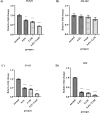Evaluation of Drug Resistance in the Tamoxifen-treated MKN-45 Gastric Cancer Cell Line via the Epithelial-mesenchymal Transition Signaling Pathway
- PMID: 39006197
- PMCID: PMC11240059
- DOI: 10.22088/IJMCM.BUMS.12.4.361
Evaluation of Drug Resistance in the Tamoxifen-treated MKN-45 Gastric Cancer Cell Line via the Epithelial-mesenchymal Transition Signaling Pathway
Abstract
One of the major challenges in gastric cancer (GC) chemotherapy is the phenomenon of multi-drug resistance (MDR). The epithelial-mesenchymal transition (EMT) and its key molecules, transforming growth factor-β (TGFβ) and SMAD2, play a central role in MDR occurrence. Tamoxifen (TAM), a triphenylethylene derivative, can overcome MDR in human gastric cancers. The aim of this study was to investigate the effect of TAM on 5-FU resistance of GC by suppressing the TGFβ1/SMAD2 signaling pathway and EMT. The MKN-45 cell line was subjected to treatment with 5-FU, TAM and a combination of both. The MTT assay was used to investigate the cytotoxic effects of 5-FU and TAM, and the DNA laddering technique was used to assess DNA fragmentation and apoptosis. Real-time RT-PCR examined the change in gene expression in EMT-related genes (SNAI2, VIM, TGFβ1 and SMAD2). The results of the present study indicated that not only TAM treatment significantly decreased the IC50 of 5-FU (P≤0.05), but also the addition of TAM to 5-FU induced apoptosis in the MKN-45 cell line. Treatment with TAM and 5-FU significantly inhibited TGFβ1 and TGFβ1-induced expression of EMT markers (VIM and SNAI2) in MKN-45 cells (P≤0.05). The reduction of TGFβ1 targets downstream of the SMAD2 signaling pathway reversed the process of EMT and significantly increased the sensitivity of MKN-45 cells to 5-FU. The results of the present study suggested that reversal of EMT-mediated MDR via the TGFβ1/SMAD signaling pathway using TAM may be a potential new therapeutic strategy to overcome chemoresistance to 5-FU during GC chemotherapy.
Keywords: Epithelial-mesenchymal transition; TGFβ1/ SMAD2 signaling pathway; drug resistance; Tamoxifen; gastric cancer.
© The Author(s).
Figures



References
LinkOut - more resources
Full Text Sources
Research Materials
Miscellaneous
